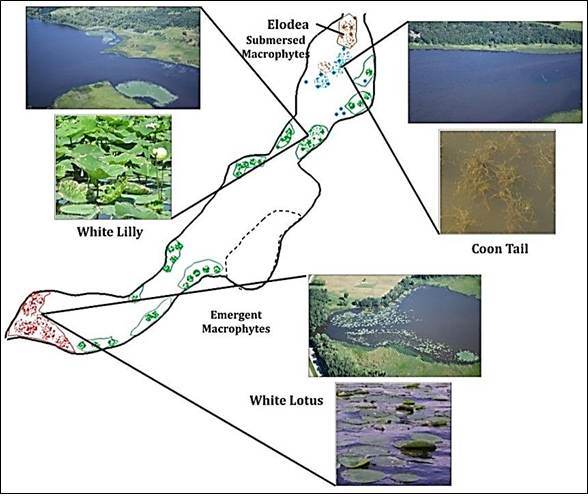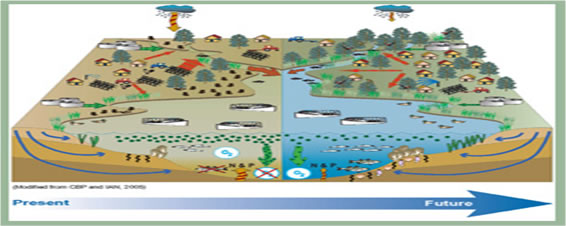Wetlands have widely recognized functions of water quality improvement. For example, floodplain wetlands can trap sediment and phosphorus in streams. Recent studies show that many wetlands altered by humans were drained to support agricultural use. Indirect impacts from pollutants, urban runoff, and non-native species invasion continue to degrade wetlands. While the value of wetland restoration to improve water quality are recognized, our understanding and estimate of potential benefits of floodplain wetlands restoration are still limited. We are interested in studying the effects of vegetation characteristics (density, distribution, submerged and emergent vegetation) on surface water and sediment processes. Accurate and efficient mapping of vegetation and sub-bottom conditions in shallow waters can provide a valuable monitoring tool for reclaiming lakes, rivers, streams, and wetlands. To better examine the effectiveness of restoring aquatic habitats, reliable and effective monitoring tool can be valuable. We employ the newly developed technique that combines a ground penetrating radar (GPR), a side scanning sonar (SSS), and sub-bottom profiler (SBP) to effectively determine the presence of vegetation in target areas (e.g. wetland restoration project at the Cherokee Marsh). Furthermore, we are deploying a series of floating bog interceptors (FBIs) that are designed to incorporate ecology and ecosystem services into shoreline wetland/coastal engineering protection. A coupled wetland hydrodynamic and sediment model has been developed to evaluate the the outcome of reclaiming Cherokee Marsh using FBIs. Furthermore, we also focus on examine the function of FBIs including (i) diminishing wave energy attacking the shoreline, (ii) diverting flow directions and trapping sediments at the downstream, and (iii) re-establishing natural vegetation on the shoreline. More details of the work can refer to several sources: Isthmus-2012, news, and Yahara 101 talk in 2014 and UW-News in 2015. Some other sources related to the beauty of the Cherokee Marsh can be found from the Instagram. Studies for Cherokee-Yahara River Estuary rehabilitation can be found here.

Floating bogs as a wave attenuator Floating bogs as wildlife habitat Floating bogs as a shoreline accretion agent Cherokee Marsh restoration
Two alternative states exist in shallow lakes: one with clear water, characterized with abundant submerged macrophytes, and the other with turbid eutrophic water, dominated by phytoplankton. Aquatic macrophytes are usually acted to substantially stabilize sediments bed and increase bed consolidation, yielding the reduction of suspended sediments in the water column to have better water clarity. Once sediment resuspension decreases and water quality improves, higher light availability can promote macrophytes growth. On the other hand, aquatic macrophytes may change aquatic environment and reduce sediment resuspension through their developments. Nevertheless it is unclear if two alternative states for an intermediate-depth lake (2.5 m ~ 5 m) still hold. If macrophytes can grow in the deeper regions of an intermediate-depth lake, sediment resuspension would reduce and the eutrophic state would change back to a clear water state. Our research questions are: What is the role of turbulence on sediment resuspension in vegetated/non-vegetated areas and carp/without-carp areas? What are the differences of wave-current and turbulence in vegetated and nu-vegetated areas, and how are their interactions to sediment resuspension? Better answer these research questions would be critical for the ongoing Lake Wingra restoration project.

Two alternative states of shallow lakes Sources of turbidity Types of aquatic macrophytes Lake Wingra restoration
Sponsor :
City of Madison, WI
Dane County Land and Water Resources
Department
Hilldale
Undergraduate/Faculty Research Fellowships
NSF-North Temperate Lakes Long-Term Ecological Research
Wisconsin Department of Natural
Resources
Student Investigators:
Brent Teske (MS), John Reimer (PhD)
Graduated: Kevin Lin (PhD), Henry Yuan (PhD),Nobuaki Kimura (PhD), Khurran Khan (MS), Nathan Gerdts (MS), Gary Guo (MS), Michael Busch (MS), Katie Nagel (Undergraduate) ,
Collaborators:
Dr. Richard "Dick" Lathrop at Center of Limnology and WDNR
Kevin Connors, Formal Director of Dane County Land & Water Resources
Mr. Kurt Welke, Wisconsin Department of Natural Resources
Ms. Sue Josheff, Wisconsin Department of Natural Resources
Mr. Russ Hefty, Conservation Resource Supervisor, City of Madison
Mr. Greg Fries, City of Madison
Ms Cynthia Chin, East High School, Madison, WI
Publications:
- Torma, P.
and Wu, C.H. Temperature and circulation
dynamics in a small and shallow lake: Effects of under
weak stratification and littoral submerged
macrophytes, Water, 11(1), 128;
doi:10.3390/w11010128,
2019.
- Kimura, N., Wu, C.H., Hoopes, J.A., and Tai, A.
Diurnal thermal dynamic processes in a small and shallow
lake under non-uniform wind and weak stratification,
Journal of Hydraulic Engineering - ASCE, 10.1061/(ASCE)HY.1943-7900.0001190,
142(11), 04016047, 2016.
- Lin, Y.T. and Wu, C.H., Effects of a sharp change of emergent vegetation distribution on thermally driven flow over a stratified slope, Environmental Fluid Mechanics,15(4), 771-791, 2015.
- Lin, Y.T. and Wu, C.H., The role of rooted emergent vegetation on periodically thermal-driven flow over a sloping bottom. Environmental Fluid Mechanics, 14(6), 1303-1334, 2014.
- Lin. Y.T. and Wu, C.H., Response of bottom sediment stability after carp removal in a small lake, Annales de Limnologie - International Journal of Limnology, 49 (03), 157-168, 2013.
- Wu, C.H., Young, C.C., and Yuan, H.L., Non-hydrostatic modeling of vegetation effects on wave and flow motions, 10th Estuarine and Coastal Modeling, 304-321, 2008.
- Teske, B., Floating Bog Interceptor Gardens: A Novel Approach to Address Shoreline Erosion in an Inland Lake, Master Thesis, Dept. of Civil and Environmental Engineering, UW-Madison, 2018.
- Busch, M, Design and performance evaluation of Floating Bog Interceptors (FBIs) to protect and restore Cherokee Marsh, WI, Master Thesis, Dept. of Civil and Environmental Engineering, UW-Madison, 2017.
- Gerdts, N. Comparison of external and internal loads in a shallow lake. Master Thesis, Dept. of Civil and Environmental Engineering, UW-Madison, 2015.
- Wu, C.H., Lathrop, R.C., Welke, K., Sediment and Carp Dynamics in Lake Mendota’s Yahara River Estuary. WDNR Planning Report, 2013.
- Wells, N.J., Common carp (Cyprinus carpio) seasonal movement and their effects on water quality in the Cherokee freshwater estuary, Madison, Wisconsin, USA, Master Thesis, Civil and Environmental Engineering, UW-Madison, 2013.
- Lin, Y.T., Sediment Transport processes in shallow
water environment, Ph.D dissertation, Dept.
of Civil and Environmental Engineering,
UW-Madison,
2012.
- Khurran Sattar Khan, Sediment dynamics in Cherokee
Marsh, WI, Master Thesis, Dept. of Civil and
Environmental Engineering, UW-Madison, 2010.